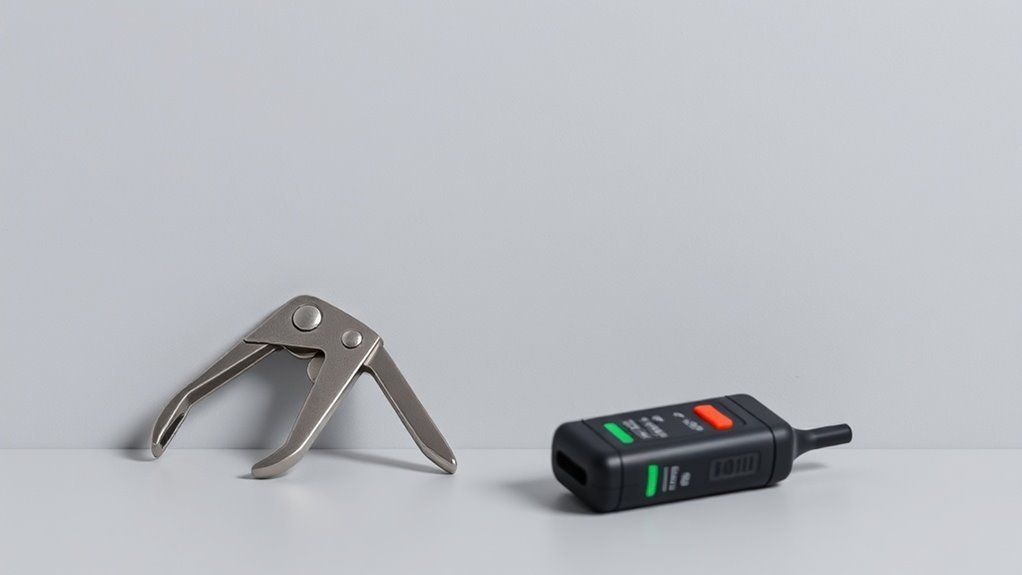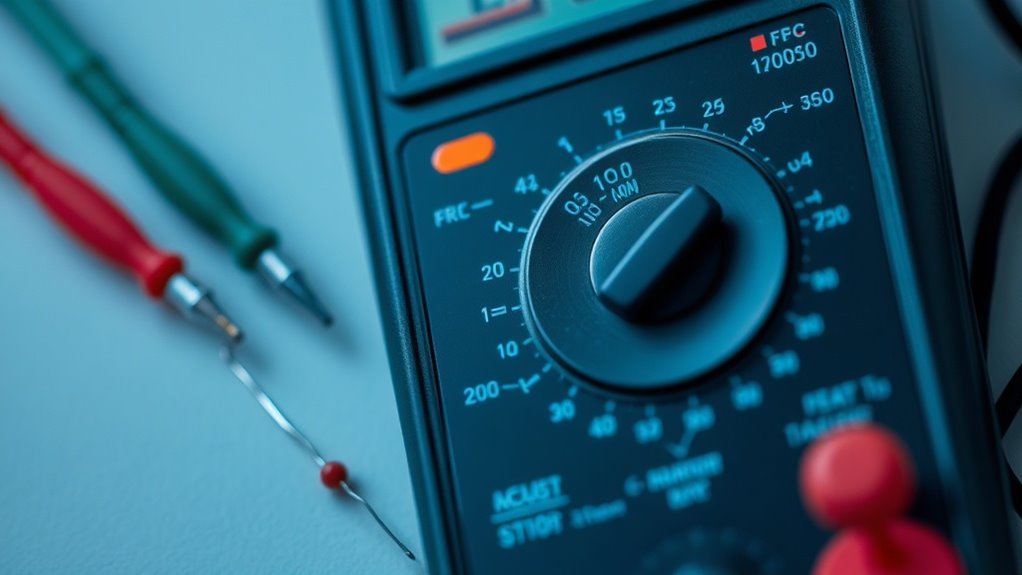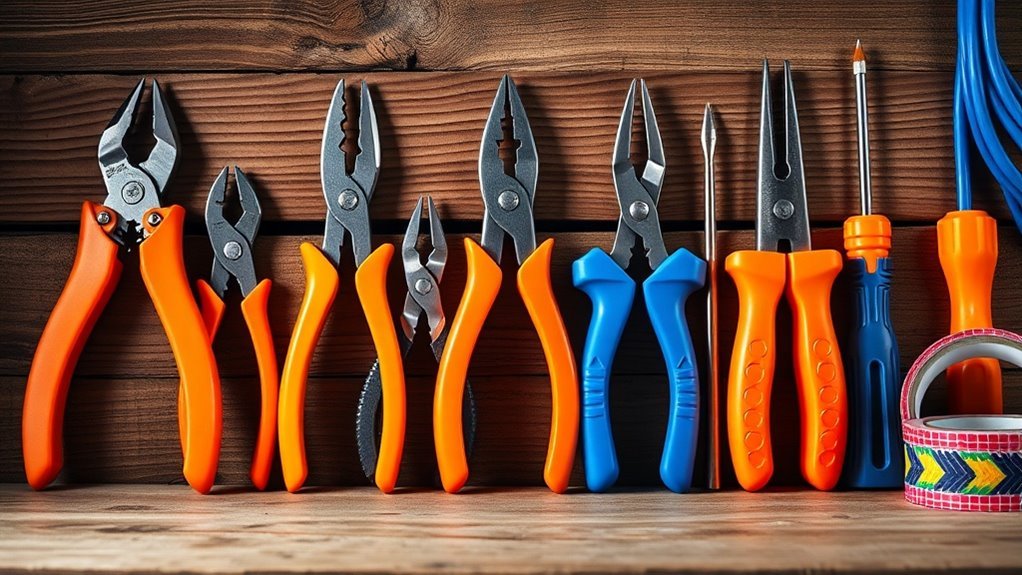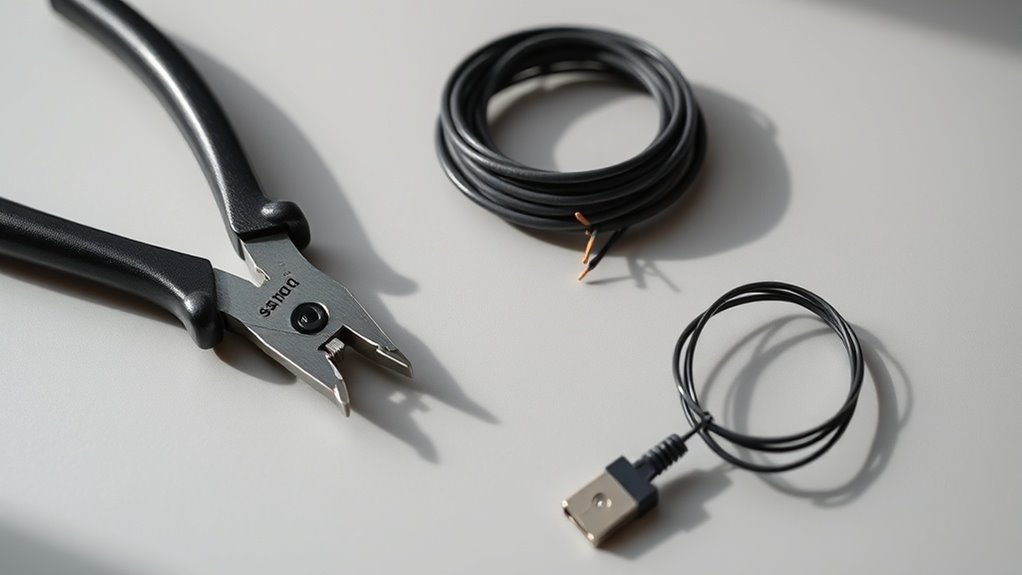Importance of Fuse Pullers and Circuit Testers

Fuse pullers and circuit testers are vital for safe electrical maintenance. They protect you from electric shocks while replacing fuses and diagnosing electrical issues. Fuse pullers keep your hands away from live circuits, and they provide a secure grip, making fuse replacement easier and safer. Circuit testers help identify faults quickly and accurately, ensuring that your electrical systems run smoothly. By understanding their importance, you’ll discover essential practices for using these tools effectively and safely.
Key Takeaways
- Fuse pullers enhance safety during fuse replacements by providing insulated handles that keep hands away from live circuits.
- Circuit testers quickly diagnose electrical issues, saving time while ensuring accurate measurements to reduce troubleshooting errors.
- Using fuse pullers minimizes damage to fuses and sockets, promoting longevity and reliability in electrical systems.
- Both tools increase user confidence in maintenance tasks by ensuring safe and efficient handling of electrical components.
- Regular use of these tools adheres to best practices in electrical maintenance, significantly reducing the risk of electric shock and equipment failure.
Understanding Fuse Pullers: A Essential Safety Tool
Fuse pullers are essential safety tools designed to help you replace fuses without risking injury. They’re specifically crafted to grip, pull, and disconnect fuses safely, keeping your hands away from potential electrical hazards.
When dealing with electrical systems, safety should always come first, and using a fuse puller minimizes your chances of accidental electric shock. These handy tools often feature insulated handles, ensuring you have a secure grip and added protection while working.
Moreover, they’re compact and easy to store, making them a convenient addition to your toolkit. By using a fuse puller, you can confidently tackle fuse replacements, knowing you’re taking the necessary precautions for your safety and well-being.
How Fuse Pullers Work

Fuse pullers are designed to safely remove blown fuses from electrical panels without risking shock or injury.
They typically feature insulated handles and a unique gripping mechanism that makes the process easier.
Understanding how these tools work can greatly enhance your safety while handling electrical systems.
Mechanism of Fuse Pullers
While you might be familiar with circuit breakers, understanding how fuse pullers work is equally important for safely handling electrical systems.
A fuse puller is designed to grip fuses securely, allowing you to remove or replace them without risking injury. It typically features a pair of insulated handles that keep your hands away from live circuits.
When you squeeze the puller’s handles, the jaws close around the fuse, creating a firm grip. You can then pull the fuse straight out of its socket without making contact with any conductive parts.
This mechanism guarantees that you’re capable of performing maintenance or troubleshooting while minimizing the risk of electrical shock or damage.
It’s a simple yet essential tool for anyone working with fuses.
Safety Features Explained
Understanding how fuse pullers incorporate safety features is essential for anyone working with electrical systems. These tools are designed with insulated grips, ensuring you stay protected while removing fuses.
When using a fuse puller, you’ll notice they provide a secure grip, minimizing the risk of slippage and accidental contact with live electrical parts.
Additionally, fuse pullers often feature built-in safety mechanisms, like a sturdy frame that withstands high pressure, which helps prevent accidents. Some models include a non-conductive material, further protecting against shocks.
Common Applications Overview
When it comes to electrical work, using a fuse puller can greatly simplify the process of replacing or checking fuses in various applications. Whether you’re dealing with home appliances, automotive systems, or industrial machinery, a fuse puller lets you remove fuses easily and safely.
Instead of risking damage to your fingers or the fuse itself, you can grip, pull, and inspect fuses with precision. This tool’s ergonomic design guarantees you maintain a secure hold while preventing electrical shocks.
Additionally, some fuse pullers come equipped with integrated features like screwdrivers or circuit testers, making it multifunctional. In short, having a fuse puller on hand can streamline maintenance tasks and enhance your overall efficiency in electrical work.
The Benefits of Using Fuse Pullers

Using fuse pullers can greatly enhance your safety while working with electrical systems. They help prevent circuit damage by ensuring fuses are removed properly and efficiently. Plus, you’ll find that tasks can be completed quicker, letting you focus on other important aspects of your project. Additionally, proper use of fuse pullers contributes to identifying faulty fuses and maintaining a secure electrical environment.
Enhanced Safety Measures
Although electricity powers our daily lives, handling fuses can pose serious risks, making the role of fuse pullers essential for safety. These handy tools not only reduce the likelihood of electrical shocks but also make it easier to replace fuses safely.
Here are some key benefits of using fuse pullers:
- Protection Against Electric Shock: Keeps your hands safely away from live wires.
- Improved Grip: Offers a secure hold, making it easier to pull fuses.
- Minimized Damage: Reduces wear and tear on fuses and sockets.
- Convenient Design: Often made ergonomically, guaranteeing comfortable use for extended periods.
Incorporating fuse pullers into your electrical maintenance toolkit can help guarantee a safer working environment.
Preventing Circuit Damage
One of the key benefits of fuse pullers is their ability to prevent circuit damage during maintenance. By using a fuse puller, you can safely remove fuses without risking damage to your electrical components or the fuse itself. This tool minimizes the chances of short circuits and electrical arcing, which can lead to costly repairs or replacements.
Here’s a quick breakdown of the advantages:
| Benefit | Impact on Maintenance | Outcome |
|---|---|---|
| Safe Removal | Reduces risk of accidents | Prevents injury and damage |
| Concentrated Gripping | Enhances control | Minimizes fuse breakage |
| Insulated Design | Prevents electrical shocks | Increases user safety |
Using a fuse puller is a smart choice for anyone working with electrical circuits.
Improved Efficiency and Speed
When you need to replace fuses quickly, having a fuse puller can greatly enhance your efficiency. It streamlines the process, allowing you to get the job done without wasting valuable time.
Here are some key benefits of using fuse pullers:
- Speedy Removal: Quickly extract fuses without fumbling or wasting time.
- Reduced Risk: Minimize the chance of electrical shock or damage to components.
- Comfort Grip: Enjoy a secure hold, so you won’t accidentally drop or misalign the fuse.
- Versatile Use: Suitable for various fuse sizes and types, making it a handy tool for different projects.
What Are Circuit Testers?
Circuit testers are essential tools for anyone working with electrical systems, whether in homes or vehicles. These devices help you determine the presence of voltage, continuity, and overall circuit functionality.
By using a circuit tester, you can quickly identify faults in wiring, ensuring safe and effective repairs or installations. They’re especially handy when troubleshooting electrical issues, as they provide immediate feedback on the circuit’s status.
With a circuit tester, you won’t have to guess if a wire is live or if a connection is secure. You’ll not only enhance your efficiency but also improve safety while handling electrical tasks.
Different Types of Circuit Testers
While maneuvering the world of electrical systems, understanding the different types of circuit testers can significantly enhance your troubleshooting capabilities.
Each type serves its unique purpose, making it essential to know what you’re dealing with.
- Non-Contact Voltage Tester: Detects voltage without touching the wire, guaranteeing safety.
- Multimeter: Measures voltage, current, and resistance, providing versatile testing options.
- Continuity Tester: Checks if a circuit is complete, helping identify breaks in the wiring. This is crucial for ensuring circuit integrity and preventing potential hazards.
- Ground Fault Circuit Interrupter (GFCI) Tester: Tests GFCI outlets to verify they’re functioning properly to prevent electrical shock.
Advantages of Circuit Testers in Diagnostics
Understanding the various types of circuit testers not only enhances your ability to identify issues but also streamlines the diagnostic process. These tools can save you time and effort by quickly pinpointing electrical problems. Their ability to measure voltage, continuity, and resistance lets you assess circuit conditions effectively. Plus, they provide instant feedback, reducing guesswork in troubleshooting. Additionally, circuit testers can provide measurements in ways similar to digital multimeters, making them essential for accurate diagnostics.
Here’s a quick overview of some advantages:
| Advantage | Description | Benefit |
|---|---|---|
| Speed | Quickly identifies faults | Cuts diagnostic time |
| Accuracy | Provides precise measurements | Reduces errors |
| Versatility | Works on various circuits and devices | Increases usability |
Using circuit testers can vastly improve your diagnostics, making repairs more efficient and reliable.
Best Practices for Using Fuse Pullers and Circuit Testers
When it comes to working with fuse pullers and circuit testers, following best practices can greatly enhance safety and efficiency.
To get the most out of these tools, keep these tips in mind:
- Always verify the power is off before testing or pulling fuses.
- Use the correct size and type of fuse puller for your specific application.
- Inspect both the fuse puller and circuit tester for damage before use.
- Maintain a clean, organized workspace to prevent accidents while you work.
Common Mistakes to Avoid When Using These Tools
Although using fuse pullers and circuit testers may seem straightforward, there are common mistakes that can lead to safety hazards or ineffective results. One mistake is assuming you can use any fuse puller for any fuse size; always match the tool to the specific fuse type.
Another error isn’t checking the circuit tester’s battery or functionality before use, which can result in inaccurate readings. Additionally, some users neglect to properly disconnect the power supply before testing, increasing the risk of electric shock.
Finally, forgetting to follow manufacturer guidelines can lead to tool damage or personal injury. By avoiding these pitfalls, you’ll use your tools safely and effectively, ensuring better results in your electrical maintenance tasks.
Key Takeaways for Safe Electrical Maintenance
Using fuse pullers and circuit testers safely is key to effective electrical maintenance. To guarantee your safety and the longevity of your electrical systems, keep these takeaways in mind:
- Always disconnect power: Before using any tools, make sure the power is turned off to avoid accidents.
- Use insulated tools: Opt for tools with rubber grips to minimize shock risk.
- Check your equipment: Regularly inspect fuse pullers and circuit testers for damage or wear to guarantee accuracy and safety.
- Educate yourself: Stay updated on best practices and safety protocols to enhance your knowledge and skills.
- Understanding insulation principles is essential to ensuring reliable protection from electrical hazards while performing maintenance tasks.
Questions
Can I Use Fuse Pullers on Automotive Fuses?
Yes, you can use fuse pullers on automotive fuses. They’re designed to safely grip and remove fuses, preventing damage to the fuse or fuse box. Just make certain you have the right size for your specific fuses.
How Often Should I Test My Circuit Tester?
You should test your circuit tester every three months. Curiously, about 25% of testers fail to provide accurate readings over time. Regular checks guarantee you’re always ready for safe and reliable electrical troubleshooting when needed.
Are There Any Safety Certifications for Fuse Pullers?
Yes, there are safety certifications for fuse pullers, like UL (Underwriters Laboratories) and IEC (International Electrotechnical Commission). Always look for these certifications to guarantee you’re using safe, reliable tools in your electrical work.
What Materials Are Fuse Pullers Typically Made From?
Imagine a sturdy bridge; fuse pullers are typically crafted from materials like plastic, rubber, or steel. These provide insulation and strength, ensuring you handle fuses safely without worrying about electrical shock or damage.
Can Faulty Circuit Testers Cause Electrical Hazards?
Yes, faulty circuit testers can definitely cause electrical hazards. If they’re not functioning properly, you might misjudge live circuits, increasing the risk of shock or shorts. Always check your tester before use for safety.
Conclusion
In a world buzzing with electrical chaos, fuse pullers and circuit testers are your heroic sidekicks, swooping in to save the day! By using these tools, you’re not just maintaining safety; you’re becoming an electrical wizard, warding off disaster with a flick of your wrist! So, gear up and wield your fuse puller like a knight with a sword, and let your circuit tester guide you through the dazzling domain of diagnostics! Electrical mastery awaits!






